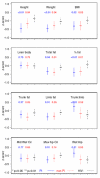Morphologic and metabolic abnormalities in vertically HIV-infected children and youth
- PMID: 19279441
- PMCID: PMC2680185
- DOI: 10.1097/QAD.0b013e3283269dfb
Morphologic and metabolic abnormalities in vertically HIV-infected children and youth
Abstract
Objective: To compare the distribution of lipid and glucose abnormalities and altered fat distribution among vertically HIV-infected patients and controls.
Design: Cross-sectional multicenter study on HIV-infected (HIV-positive) patients, 7-24 years of age, stratified by Tanner stage and protease inhibitor use (protease inhibitor, n = 161 and non- protease inhibitor, n = 79) and seronegative controls (HIV-negative, n = 146).
Methods: Measurements included fasting lipids, glucose, insulin, 2-h oral glucose tolerance test, dual-energy X-ray absorptiometry, anthropometry, and antiretroviral therapy and medical histories. Multiple linear regression models were used to compare distributions between HIV-positive and HIV-negative groups.
Results: Both HIV-positive groups had long exposures to antiretroviral therapy. Protease inhibitor and nonprotease inhibitor groups had similar current CD4 cell count and HIV-1 RNA, but the protease inhibitor group had lower nadir CD4 cell count, higher peak HIV-1 RNA, and more advanced Centers for Disease Control disease stage. In adjusted analyses, both HIV-positive groups had significantly lower mean Z scores for height, weight, BMI, and total and limb fat than the HIV-negative group. Mean triglycerides were significantly higher and high-density lipoprotein cholesterol lower in both HIV-positive groups relative to the HIV-negative group. The protease inhibitor group also had significantly higher mean total, low-density lipoprotein, and non-high density lipoprotein cholesterol. Mean fasting insulin was higher in both HIV-positive groups, and 2-h glucose and insulin were higher in the protease inhibitor group. Ritonavir was associated with increasing dyslipidemia and altered glucose metabolism.
Conclusion: In a large group of vertically HIV-infected children and youth with extensive antiretroviral therapy exposure, height, weight, and total and limb fat were lower than in controls. There was a high prevalence of lipid abnormalities among those on protease inhibitors and evidence of developing insulin resistance, factors that may accelerate lifetime risk for cardiovascular disease.
Figures
References
-
- Gortmaker SL, Hughes M, Cervia J, Brady M, Johnson GM, Seage GR, 3rd, et al. Effect of combination therapy including protease inhibitors on mortality among children and adolescents infected with HIV-1. N Engl J Med. 2001;345:1522–1528. - PubMed
-
- Palella FJ, Jr., Delaney KM, Moorman AC, Loveless MO, Fuhrer J, Satten GA, et al. Declining morbidity and mortality among patients with advanced human immunodeficiency virus infection. HIV Outpatient Study Investigators. N Engl J Med. 1998;338:853–860. - PubMed
-
- Resino S, Bellon JM, Resino R, Navarro ML, Ramos J Tomas, de Jose MI, et al. Extensive implementation of highly active antiretroviral therapy shows great effect on survival and surrogate markers in vertically HIV-infected children. Clin Infect Dis. 2004;38:1605–1612. - PubMed
-
- de Martino M, Tovo PA, Balducci M, Galli L, Gabiano C, Rezza G, Pezzotti P. Reduction in mortality with availability of antiretroviral therapy for children with perinatal HIV-1 infection. Italian Register for HIV Infection in Children and the Italian National AIDS Registry. Jama. 2000;284:190–197. - PubMed
Publication types
MeSH terms
Substances
Grants and funding
- RR-001271/RR/NCRR NIH HHS/United States
- U01 AI41089/AI/NIAID NIH HHS/United States
- R01 HD040777/HD/NICHD NIH HHS/United States
- M01 RR001271/RR/NCRR NIH HHS/United States
- U01 AI041110/AI/NIAID NIH HHS/United States
- M01 RR00069/RR/NCRR NIH HHS/United States
- 5 U01 AI41110/AI/NIAID NIH HHS/United States
- UM1 AI106716/AI/NIAID NIH HHS/United States
- M01 RR000069/RR/NCRR NIH HHS/United States
- U01 AI068632/AI/NIAID NIH HHS/United States
- U01 AI041089/AI/NIAID NIH HHS/United States
- R01 HD 40777/HD/NICHD NIH HHS/United States
LinkOut - more resources
Full Text Sources
Medical
Research Materials


